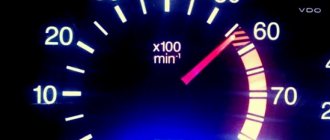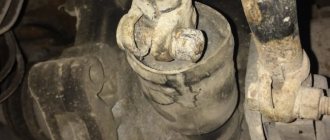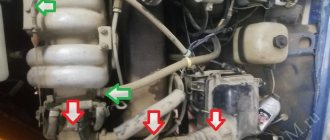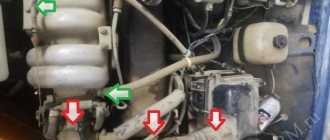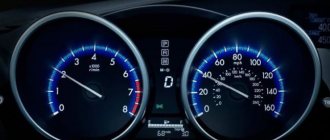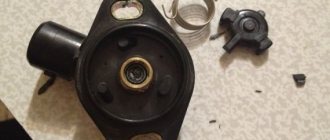When it comes to factors that affect the resource and durability of a motor, driving style is often mentioned. It also affects the resource of other elements and systems.
Because of this, many motorists have a natural desire to adhere to the safest and most correct conditions for operating vehicles. This will protect the car from premature wear, breakdowns and rapid consumption of the internal combustion engine.
The question remains open regarding what is considered a correct and gentle regime. Driving style has a lot to do with how the driver uses engine speed. Here it is important to understand how to properly manage them, and what will happen if you always keep the tachometer only in the zone of high or low speeds.
ICE resource and dependence on speed
If the driver operates the car competently and keeps the speed in the optimal range, then it will be possible to maintain the service life and even increase it.
There is an engine operating mode in which wear will be minimal.
The motorist has the power to control the behavior of the car and set it the required pace in terms of speed. RPM refers to the rotation of the crankshaft. This indicator is usually measured in thousands of revolutions per minute.
There is also the concept of a speed plateau. This is the engine speed range at which the motor can use maximum torque. After all, torque is actually the power that is available at certain speeds. Due to the torque, it is possible to make sharp accelerations and overtaking. That is, the car moves due to torque, not power.
All drivers can be roughly divided into 3 categories regarding how they manage their speed:
- The first type of drivers. They always try to keep the engine at low speeds only. Such people are sure that driving at low speeds is the most optimal.
- Second type. These are motorists who adhere to the principle of maintaining average speeds, periodically spinning the internal combustion engine above average values.
- Third type. Their engine always runs at medium and high speeds, and the needle on the tachometer often stays in the red zone. By maintaining high engine speeds, they consider their actions to be absolutely correct.
Now you need to evaluate the consequences of this or that driving style and understand whether it is possible to turn the engine at high engine speeds, and what driving at low engine speeds will bring. How will this affect the condition of the internal combustion engine and what consequences may there be.
A big question arises as to which driving is ultimately more correct and efficient, safe for the engine and its service life. Operating a car at high and low speeds has its own characteristics.
Driving at low speeds with early shifting
Often, driving school instructors and old drivers recommend that beginners drive “tight” - switch to higher gear when the crankshaft reaches 1500–2000 rpm. The former give advice for safety reasons, the latter out of habit, because previously the cars had low-speed engines. Nowadays, such a mode is only suitable for a diesel engine, whose maximum torque is in a wider speed range than that of a gasoline engine.
Not all cars are equipped with tachometers, so inexperienced drivers with this driving style should be guided by driving speed. The early switching mode looks like this: 1st gear - moving from a standstill, transition to II - 10 km/h, III - 30 km/h, IV - 40 km/h, V - 50 km/h.
Such a switching algorithm is a sign of a very calm driving style, which gives an undoubted advantage in safety. The downside is the increased wear rate of power unit parts and here’s why:
Owners of cars equipped with an on-board computer can easily convince themselves of the uneconomical nature of driving under tension. It is enough to turn on the display to show instantaneous fuel consumption.
This type of driving greatly wears out the power unit when the car is operated in difficult conditions - on dirt and country roads, with a full load or a trailer. Owners of cars with powerful engines of 3 liters or more, capable of sharp acceleration from the bottom, should not relax either. After all, to intensively lubricate the rubbing parts of the engine, you need to keep the crankshaft at least 2000 rpm.
High speed
The above may lead to the idea that it is better to spin the engine well rather than under-twisted. This will allow, if necessary, to obtain quick feedback from the engine when pressing the gas pedal.
Yes, overtaking and maneuvering are really better at high revs. But here everything is quite conditional and ambiguous. If you constantly turn the engine higher than normal, then you may encounter some problems.
High revolutions of a gasoline engine are those that exceed 70% of the available values. For diesel engines, these are parameters beyond the torque plateau.
In any case, the car has a tachometer. The tachometer displays a green and red RPM zone. When approaching the red zone as much as possible or finding yourself in it, the speed is considered increased.
Consolidation of received information about adverbs
The Russian language textbook for the 7th grade of UMK M. M. Razumovskaya includes five tasks to consolidate schoolchildren’s knowledge about participial phrases, among which we will highlight the following exercises.
● Copy, emphasizing the grammatical basis of sentences and circumstances. How are these circumstances expressed?
Using these examples, schoolchildren will talk about punctuation marks in participial phrases and identify the sentence (third) that contains the participial phrase, graphically designate it and draw a conclusion about the main difference between participial and participial phrases.
● Copy by inserting missing letters and punctuation marks. Emphasize the grammatical basis of the sentences. Indicate the adverbial phrases.
We offer an option for completing this task:
When performing this exercise, seventh-graders will definitely see the use of the participial phrase in the text (in sentences 1 and 2), indicate it graphically and name the questions that the participial phrase answers ( which? which? which?
etc.) and participle phrases (
how? how?,
etc.).
In the textbook on the Russian language for the 7th grade of UMK by V.V. Babaytseva (p. 92-98), we would like to highlight several exercises, the implementation of which, in our opinion, will develop in schoolchildren the ability to use participial phrases.
● Choose dependent words that suit the meaning of the participles. (Watch the word order!) Write down the sentences, emphasizing the adverbial phrases and explaining the placement of commas.
● Here are sentences with punctuation errors. Explain the reason for their occurrence. Write down the sentences in corrected form.
By correcting punctuation errors in these sentences, seventh-graders will learn to see the “boundaries” of adverbial verbs and draw a conclusion about the importance of analyzing sentences of this nature.
Russian language. 7th grade. Tests
The authors note that the manual is intended to organize systematic control of the student. In particular, for self-control. The collection presents a system of training test tasks for all sections of the 7th grade curriculum. The accessible format of the publication allows for test control at school and at home. A collection of test tasks in the Russian language from the UMK line M.M. Razumovskaya consists of two parts - linguistic and speech.
Buy
Optimal speed
Based on everything said earlier, it is natural to ask at what speeds it is better to drive and whether it is possible to turn the engine higher than normal or drop to minimum values.
At high and low speeds, the engine will suffer, wear out faster and provoke the occurrence of various malfunctions.
It is recommended to stick to average speed indicators, using the tachometer of your car as a guide. To preserve the resource of the internal combustion engine, it is better to use average or slightly above average values.
Study your car's tachometer. There is a so-called green and red zone. On most passenger cars, the green zone ends at approximately 6000-7000 rpm. In this case, the range from 2500-3000 to 4500-5000 rpm will be considered optimal.
When designing naturally aspirated engines, designers try to ensure that the torque plateau is in this range. Turbo engines have better traction at lower speeds, and their shelf is wider compared to naturally aspirated engines. But it is better to spin turbocharged engines within the specified limits.
Or follow a different rule. Keep the revs within 30-70% of the values available on the tachometer gauge. This contributes to minimal negative impact on the engine.
Preventive promotion
There is such a thing as preventative engine spin-up. This is done only on a serviceable engine that is warmed up to operating temperature. It should contain relatively fresh and high-quality oil.
The motor spins up to 80-90% of its speed. It is recommended to drive about 10-20 km. on a flat road.
Auto mechanics advise carrying out this procedure at approximately intervals of 4000-5000 km. or once every 4-6 months. This evens out wear on the cylinder walls and promotes the combustion of deposits, protecting the engine from possible detonation.
Knowing how and when to operate the engine, you will be able to minimize its wear and increase its service life.
How to ride correctly?
If you are not a race car driver or a fan of hard driving, who find it difficult to relearn and change your driving style, then to save the power unit and the car as a whole, try to keep the engine operating speed in the range of 2000–4500 rpm. What bonuses will you receive:
Recommendation. On most modern cars equipped with high-speed gasoline engines, it is better to change gears when the threshold of 3000 ± 200 rpm is reached. This also applies to the transition from high to low speed.
As mentioned above, car dashboards do not always have tachometers. For drivers with little driving experience, this is a problem, since the crankshaft rotation speed is unknown, and a beginner cannot navigate by sound. There are 2 options for solving the issue: buy and install an electronic tachometer on the dashboard, or use a table that shows the optimal engine speed in relation to the speed in different gears.
| 5-speed gearbox position | 1 | 2 | 3 | 4 | 5 |
| Optimal crankshaft rotation speed, rpm | 3200–4000 | 3500–4000 | not less than 3000 | > 2700 | > 2500 |
| Approximate vehicle speed, km/h | 0–20 | 20–40 | 40–70 | 70–90 | more than 90 |
Note. Considering that different brands and modifications of cars have different speeds and revolutions, the table shows average indicators.
A few words about coasting down a mountain or after acceleration. Any fuel supply system has a forced idle mode, which is activated under certain conditions: the car is coasting, one of the gears is engaged, and the crankshaft speed does not fall below 1700 rpm. When the mode is activated, the supply of gasoline to the cylinders is blocked. So you can safely brake the engine at high speed without fear of wasting fuel.
Source
What should the engine idle speed be for a Toyota Corolla E120?
Now she is almost invisible. The reasons can be in 2 variations: injection system and mechanical. Mechanical - these are engine mounts, I very often read that people change the mounts of some brand and the vibration increases or, on the contrary, decreases. Since the engine itself vibrates, and in order to calm it down, it is necessary to dampen 2 types of vibrations - low frequency and medium (high). A soft pillow can dampen low frequencies, and a hard one can dampen medium and high frequencies. The engine has places that practically do not crack, but there are places that vibrate.
Also read: Is It Possible to Remove Maternal Kopetal Every Year for Any Needs?
Why is the engine shaking? Shaking is an imbalance. The 6-cylinder internal combustion engine is the most balanced engine, the 4-cylinder is not particularly balanced. Since the fuel burns differently each time (injection is individual for each cylinder + spark plugs, etc.), different forces appear that act on the crankshaft (i.e., each connecting rod pushes the crankshaft differently). In a 6-cylinder internal combustion engine, the crankshaft is spread 120 degrees, and this balances the forces from the connecting rods to the crankshaft. The 4-cylinder engine has a 180-degree routing, which gives vibration. Everyone has seen the flywheel, the heavier it is, the more it smooths out the imbalance of crankshaft forces, the more balanced the engine is and the higher the charge of kinetic energy (like on inertia cars), but the heavier the flywheel, the harder it is to spin it, and this eats more gasoline, not so fast gaining health, etc.
Throttle valve
If after all the checks and measurements carried out above it was not possible to identify a malfunction, then all that remains is to check the condition of the throttle valve assembly. To do this, the part should be dismantled and then cleaned of dirt using cotton swabs. The cleaned part (or rather, all its pipes and tubules) is blown with compressed air using a compressor.
Special attention should be paid to the channel that serves to remove gases from the crankcase. Before starting purging, it should be filled with a cleaning compound and allowed to stand for some time, after which the purging itself should be performed. This is caused by the extremely small diameter of the internal channel, as a result of which other methods of cleaning it are simply not available.
In addition to all of the above breakdowns, a breakdown of the DPKV sensor, as well as the Hall sensor, can also lead to “floating” speed. If they fail, the Check Engine light will light up on the car panel. If such a malfunction occurs, it is best to contact a service center, since special equipment is required to check these sensors.
Cleaning the throttle VAZ 2114
What engine speed should be at idle?
Seryozha (Ilsa) *160, the sprocket was set to 14 teeth, I set it to 18, the gain is 10 km in total, full throttle, the tachometer shows 5.5 thousand rpm. It doesn’t even reach the red mark at full throttle in 5th gear. And at idle it vomits on everything, what's the matter, can anyone in the know tell me?
Kirill (Antoninus) Hello, Eurotex Dakota motorcycle engine fmj 162, I changed the piston, the motorcycle stopped starting, cleaned the carburetor, it started starting, but when I started riding I noticed the motorcycle stopped picking up more than 3 thousand rpm, what could be the problem
Also read: Cost of registering a car with the traffic police with replacement plates

